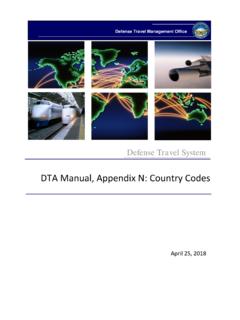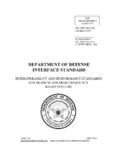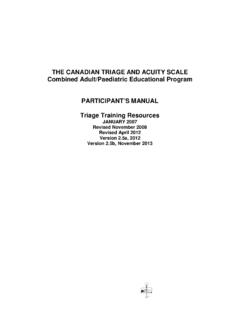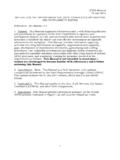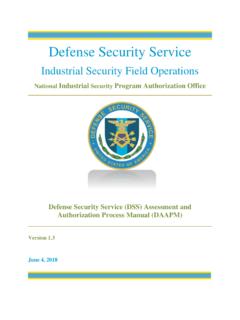Transcription of PRROOJJEECCTT EMMAANNAAGGEEMMENNTT …
1 State of Michigan (SOM) PPRROOJJEECCTT MMAANNAAGGEEMMEENNTT KKEEYY TTEERRMMSS,, DDEEFFIINNIITTIIOONNSS AANNDD AACCRROONNYYMMSS August 2013 Department of Technology, Management & Budget Table of Contents July 2013 Page 1 Table of Contents Key Terms, Definitions, and Acronyms .. 2 - A - .. 2 - B - .. 3 - C - .. 4 - D - .. 8 - E - .. 9 - F - .. 10 - G - .. 11 - H - .. 11 - I - .. 12 - L - .. 12 - M - .. 13 - N - .. 14 - O - .. 14 - P - .. 14 - Q - .. 18 - R - .. 19 - S - .. 20 - T - .. 21 - V .. 22 - W - .. 22 July 2013 Page 2 Key Terms, Definitions, and Acronyms Following is a list of common terms, definitions, and acronyms used within the project management industry.
2 While many of these terms are not mentioned within the body of SUITE documents, they are nonetheless important to understand project management. If you need further information on any of the subjects in the following list, please consult the State of Michigan Project Management Methodology (PMM) and the variety of sources listed in the Resources and Reference list in the Appendix. These terms are taken from several sources, including State of Michigan SUITE documents and the Project Management Body of Knowledge (PMBOK ). - A - Acceptance Criteria Those criteria, usually stated in a contract and/or SOW, that includes deliverables, performance requirements and essential conditions, which must be met to complete project deliverables and be accepted. Acquisition Process The process of acquiring personnel/goods/services for new or existing work within the general definitions of contracts requiring an offer and acceptance, consideration, lawful subject matter, and competent parties.
3 Action Item Status A list of problem issues including a description, point of contact, and dates of action and resolution. Action Plan A plan that describes what needs to be done and when it needs to be completed. Project plans are action plans. Activity The work or effort needed to achieve a result. An activity consumes time and usually consumes resources. Activity Definition Identifying the specific activities which must be performed in order to produce the various project deliverables. Activity Duration The time in calendar units between the start and finish of a schedule activity. See also duration. Activity Duration Estimating Estimating the number of work periods that will be needed to complete individual activities. Actual Cost Total costs incurred (direct and indirect) in accomplishing work during a given time period. Administrative Closure Generating, gathering, and disseminating information to formalize project completion. Alternative Analysis Breaking down a complex scope situation for the purpose of generating July 2013 Page 3 and evaluating different solutions and approaches.
4 Analysis The study and examination of something complex and the separation into its more simple components. Analysis typically includes discovering not only what the parts of the item being studied are, but also how they fit together. An example is the study of schedule variances for cause, impact, corrective action, and results. Application Area A category of projects that have a common element not present in all projects. Application areas are usually defined in terms of either the product of the project ( , by similar technologies or industry sectors) or the type of customer ( , internal vs. external, government vs. commercial). Application areas often overlap. Approve To accept as satisfactory. Approval implies that the item approved has the endorsement of the approving entity. The approval may still require confirmation by somebody else, as in levels of approval. In management use, the important distinction is between approve and authorize. See Authorization.
5 Areas of Responsibility Used to define the person or organizational entity responsible for specific policy areas, processes, and procedures as identified. The current levels of responsibility are Legislature, Department of Management and Budget, state agency, and customer. Arrow Diagramming Method (ADM) A network diagramming technique in which activities are represented by arrows. The tail of the arrow represents the start and the head represents the finish of the activity (the length of the arrow does not represent the expected duration of the activity). Activities are connected at points called "nodes" (usually drawn as small circles) to illustrate the sequence in which the activities are expected to be performed. Authorization The power granted by management to specified individuals allowing them to approve transactions, procedures, or total systems. Defined as the final organization authority. Assumptions Factors that, for planning purposes, are considered to be true, real, or certain without proof or demonstration.
6 Authorized Work An effort that has been approved by higher authority and may or may not be defined. - B - Backward Pass The calculation of late finish dates and late start dates for the uncompleted portions of all network activities. Determined by working backwards through the network logic from the project's end date. Baseline The original plan (for a project, a work package, or an activity) plus or minus approved changes. Usually used with a modifier ( , cost baseline, schedule baseline performance measurement baseline). July 2013 Page 4 Budget When unqualified, refers to an estimate of funds planned to cover a project or specified period of future time. When approved, the estimate for the project or any work breakdown component or any schedule activity. Budget At Completion (BAC) The estimated total cost of the project when done. Planned Value The sum of the approved cost estimates including any overhead allocation) for activities (or portions of activities) scheduled to be performed during a given period (usually project-to-date).
7 Bottom-Up Estimating (Technique) A method of estimating a component of work. The work is decomposed into more detail. An estimate is prepared of what is needed to meet requirements of each of the lower, more detailed pieces of work, and these estimates are then aggregated into a total quantity for the component of work. The accuracy of bottom-up estimating is driven by the size and complexity of the work identified at the lower levels. Business Impact Analysis Identifies project constraints, alternatives, and related assumptions as they apply to the initiation phase. Business Plan Model used by a manager for planning and scheduling project work. - C - Calendar Unit The smallest unit of the calendar produced. This unit is generally in hours, days, or weeks. It can also be grouped in shifts. Champion A person who takes on personal responsibility for the successful completion of a visionary project. Change Control The process of controlling, documenting, and storing the changes to control items.
8 This includes proposing the change, evaluating, approving or rejecting, scheduling and tracking. Change Control Board (CCB) A formally constituted group of stakeholders responsible for approving or rejecting changes to the project baselines. Change in Scope A change in objectives, work plan, or schedule resulting in a material difference from the terms of previously granted approval to proceed. Change Management Process A set of tasks or procedures established to ensure that project performance is measured to the baseline and changes are reviewed, approved or rejected, and the baseline is updated. Change Request Requests to expand or reduce the project scope, modify the costs or budgets, or revise schedules. July 2013 Page 5 Chart of Accounts Any numbering system used to monitor project costs by category ( , labor, supplies, materials).
9 The project chart of accounts is usually based upon corporate chart of accounts of the primary performing organization. Charter A document issued by the initiator of the project, usually the project sponsor, that formally authorizes the existence of the project, and provides the project manager with the authority to apply organizational resources to project activities. Code of Accounts Any numbering system used to uniquely identify each element of the work breakdown structure. Concept An imaginative arrangement of a set of ideas. Conceptual Project Planning The process of developing broad-scope project documentation from which the technical requirements, estimates, schedules, control procedures, and effective project management will all flow. Concurrent Engineering An approach to project staffing that, in its most general form, calls for implementers to be involved in the design phase. Sometimes confused with fast tracking. Configuration Control The process of evaluating, approving or disapproving, and managing changes to controlled items.
10 Configuration Management (CM) The technical and administrative application of configuration control. It includes the maintenance of a configuration control unit, change and version control standards, and configuration of control facilities. Configuration Management is a formal discipline which provides project team members and customers with the methods and tools used to identify the product developed, establish baselines, control changes to these baselines, record and track status, and audit the product. Constraint The state, quality, or sense of being restricted to a given course of action or interaction. An applicable restriction or limitation, either internal or external, to the project that will affect the performance of the project or a process. Contingency 1) something that may happen: an event that might occur in the future, especially a problem, emergency, or expense that might arise unexpectedly and therefore must be prepared for, 2) provision made against future unforeseen events Contingency Planning The development of a management plan that identifies alternative strategies to be used to ensure project success if specified risk events occur.













